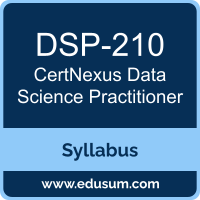 Use this quick start guide to collect all the information about CertNexus CDSP (DSP-210) Certification exam. This study guide provides a list of objectives and resources that will help you prepare for items on the DSP-210 CertNexus Data Science Practitioner exam. The Sample Questions will help you identify the type and difficulty level of the questions and the Practice Exams will make you familiar with the format and environment of an exam. You should refer this guide carefully before attempting your actual CertNexus CDSP certification exam.
Use this quick start guide to collect all the information about CertNexus CDSP (DSP-210) Certification exam. This study guide provides a list of objectives and resources that will help you prepare for items on the DSP-210 CertNexus Data Science Practitioner exam. The Sample Questions will help you identify the type and difficulty level of the questions and the Practice Exams will make you familiar with the format and environment of an exam. You should refer this guide carefully before attempting your actual CertNexus CDSP certification exam.
The CertNexus CDSP certification is mainly targeted to those candidates who want to build their career in Data Science domain. The CertNexus Certified Data Science Practitioner (CDSP) exam verifies that the candidate possesses the fundamental knowledge and proven skills in the area of CertNexus CDSP.
CertNexus CDSP Exam Summary:
| Exam Name | CertNexus Certified Data Science Practitioner (CDSP) |
| Exam Code | DSP-210 |
| Exam Price | $367.50 (USD) |
| Duration | 120 mins |
| Number of Questions | 90 |
| Passing Score | 72% |
| Books / Training | DSP training |
| Schedule Exam | Pearson VUE |
| Sample Questions | CertNexus CDSP Sample Questions |
| Practice Exam | CertNexus DSP-210 Certification Practice Exam |
CertNexus DSP-210 Exam Syllabus Topics:
| Topic | Details |
|---|---|
Defining the need to be addressed through the application of data science (7-9%) |
|
| Identify the project scope |
- Identify project specifications, including objectives (metrics/KPIs) and stakeholder requirements - Identify mandatory deliverables, optional deliverables - Determine project timeline - Identify project limitations (time, technical, resource, data, risks) |
| Understand challenges |
- Understand terminology
- Become aware of data privacy, security, and governance policies
- Obtain permission/access to stakeholder data |
| Classify a question into a known data science problem |
- Identify references relevant to the data science problem
- Identify data sources and type
- Select modeling type
|
Extracting, Transforming, and Loading Data (17-25%) |
|
| Gather data sets |
- Read Data
- Become aware of first-, second-, and third-party data sources
- Explore third-party data availability
- Collect open-source data
- Generate data assets
|
| Clean data sets |
- Identify and eliminate irregularities in data (e.g., edge cases, outliers)
- Parse the data
- Identify the sources of bias
- Mitigate the impact of bias
- Evaluate the outcomes of bias
- Monitor and improve the data cleaning process
|
| Merge and load data sets |
- Join data from different sources
- Load data
- Make an endpoint or API |
| Apply problem-specific transformations to data sets |
- Apply word vectorization or word tokenization
- Generate latent representations for image data |
Performing exploratory data analysis (25-36%) |
|
| Examine data |
- Generate summary statistics - Examine feature types - Visualize distributions - Identify outliers - Find correlations - Identify target feature(s) |
| Preprocess data |
- Identify missing values - Make decisions about missing values (e.g., imputing method, record removal) - Normalize, standardize, or scale data |
| Carry out feature engineering |
- Apply encoding to categorical data
- Split features
- Convert dates to useful features
|
Building models (19-27%) |
|
| Prepare data sets for modeling |
- Decide proportion of data set to use for training, testing, and (if applicable) validation - Split data to train, test, and (if applicable) validation sets, mitigating data leakage risk |
| Train models |
- Define models to try
- Classification
- Forecasting
- Clustering
- Train model or pre-train or adapt transformers
|
| Evaluate models |
- Define evaluation metric - Compare model outputs
- Select best-performing model
|
Testing models (4-7%) |
|
| Test hypotheses |
- Design A/B tests
- Define success criteria for test |
Operationalizing the pipeline (5-8%) |
|
| Deploy pipelines |
- Build streamlined pipeline (using dbt, Fivertran, or similar tools) - Implement confidentiality, integrity, and access control measures - Put model into production
- Ensure model works operationally
- Consider enterprise data strategy and data management architecture to facilitate the end-to-end integration of data pipelines and environments
|
Communication findings (4-7%) |
|
| Report findings |
- Implement model in a basic web application for demonstration (POC implementation)
- Derive insights from findings
- Document the model lifecycle
- Engage with diverse perspectives
- Participatory design |
| Democratize data |
- Make data more accessible to a wider range of stakeholders - Make data more understandable and actionable for nontechnical individuals
- Create a culture of data literacy
|
To ensure success in CertNexus CDSP certification exam, we recommend authorized training course, practice test and hands-on experience to prepare for CertNexus Data Science Practitioner (DSP-210) exam.
